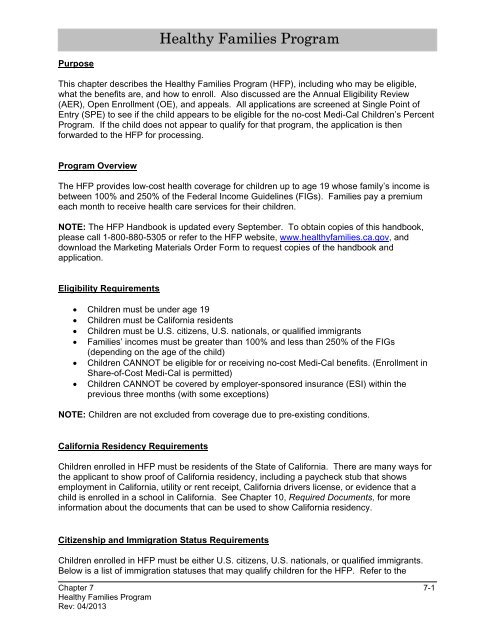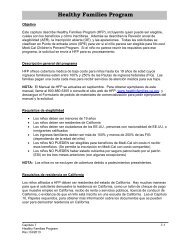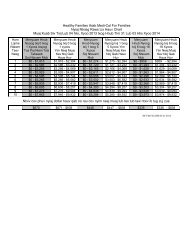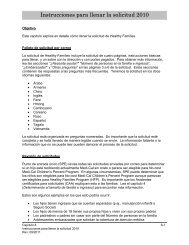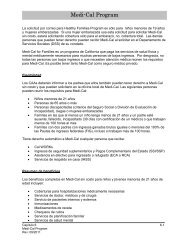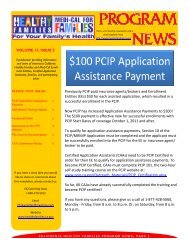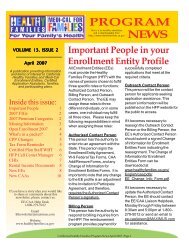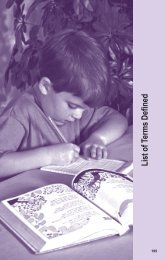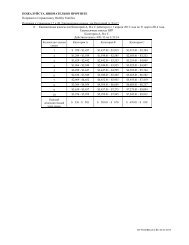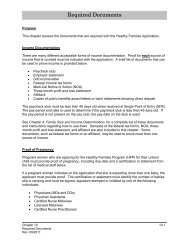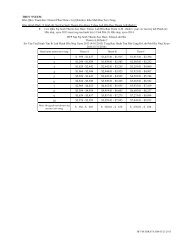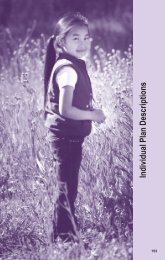Healthy Families Program - California Healthy Families - State of ...
Healthy Families Program - California Healthy Families - State of ...
Healthy Families Program - California Healthy Families - State of ...
Create successful ePaper yourself
Turn your PDF publications into a flip-book with our unique Google optimized e-Paper software.
<strong>Healthy</strong> <strong>Families</strong> <strong>Program</strong><br />
Purpose<br />
This chapter describes the <strong>Healthy</strong> <strong>Families</strong> <strong>Program</strong> (HFP), including who may be eligible,<br />
what the benefits are, and how to enroll. Also discussed are the Annual Eligibility Review<br />
(AER), Open Enrollment (OE), and appeals. All applications are screened at Single Point <strong>of</strong><br />
Entry (SPE) to see if the child appears to be eligible for the no-cost Medi-Cal Children’s Percent<br />
<strong>Program</strong>. If the child does not appear to qualify for that program, the application is then<br />
forwarded to the HFP for processing.<br />
<strong>Program</strong> Overview<br />
The HFP provides low-cost health coverage for children up to age 19 whose family’s income is<br />
between 100% and 250% <strong>of</strong> the Federal Income Guidelines (FIGs). <strong>Families</strong> pay a premium<br />
each month to receive health care services for their children.<br />
NOTE: The HFP Handbook is updated every September. To obtain copies <strong>of</strong> this handbook,<br />
please call 1-800-880-5305 or refer to the HFP website, www.healthyfamilies.ca.gov, and<br />
download the Marketing Materials Order Form to request copies <strong>of</strong> the handbook and<br />
application.<br />
Eligibility Requirements<br />
• Children must be under age 19<br />
• Children must be <strong>California</strong> residents<br />
• Children must be U.S. citizens, U.S. nationals, or qualified immigrants<br />
• <strong>Families</strong>’ incomes must be greater than 100% and less than 250% <strong>of</strong> the FIGs<br />
(depending on the age <strong>of</strong> the child)<br />
• Children CANNOT be eligible for or receiving no-cost Medi-Cal benefits. (Enrollment in<br />
Share-<strong>of</strong>-Cost Medi-Cal is permitted)<br />
• Children CANNOT be covered by employer-sponsored insurance (ESI) within the<br />
previous three months (with some exceptions)<br />
NOTE: Children are not excluded from coverage due to pre-existing conditions.<br />
<strong>California</strong> Residency Requirements<br />
Children enrolled in HFP must be residents <strong>of</strong> the <strong>State</strong> <strong>of</strong> <strong>California</strong>. There are many ways for<br />
the applicant to show pro<strong>of</strong> <strong>of</strong> <strong>California</strong> residency, including a paycheck stub that shows<br />
employment in <strong>California</strong>, utility or rent receipt, <strong>California</strong> drivers license, or evidence that a<br />
child is enrolled in a school in <strong>California</strong>. See Chapter 10, Required Documents, for more<br />
information about the documents that can be used to show <strong>California</strong> residency.<br />
Citizenship and Immigration Status Requirements<br />
Children enrolled in HFP must be either U.S. citizens, U.S. nationals, or qualified immigrants.<br />
Below is a list <strong>of</strong> immigration statuses that may qualify children for the HFP. Refer to the<br />
Chapter 7 7-1<br />
<strong>Healthy</strong> <strong>Families</strong> <strong>Program</strong><br />
Rev: 04/2013
information in the HFP Handbook on Citizenship and Immigration Information or see Chapter<br />
10, Required Documents, for more information.<br />
• An alien lawfully admitted for permanent residence<br />
• An alien granted conditional entry<br />
• An alien paroled into the U.S.<br />
• An alien with the appropriate immigration status who (or whose child or parent) has been<br />
battered or subjected to extreme cruelty in the U.S.<br />
• An alien granted asylum<br />
• A refugee admitted to the U.S.<br />
• An alien whose deportation is being withheld<br />
• An alien who is a Cuban or Haitian entrant<br />
• A qualified alien lawfully residing in any state who is an honorably discharged veteran<br />
• The spouse, unmarried dependent or unmarried surviving spouse <strong>of</strong> a qualified alien<br />
who is an honorably discharged veteran<br />
• An Amerasian immigrant<br />
NOTE: Children in the above categories are currently eligible as long as they meet the other<br />
program requirements, regardless <strong>of</strong> their dates <strong>of</strong> entry. All eligible qualified immigrants (refer<br />
to the HFP handbook for U.S. Citizenship and Immigration Service (USCIS) form numbers or<br />
Chapter 10, Required Documents) in the following status will be required to prove their date <strong>of</strong><br />
entry on the required documents:<br />
• Alien lawfully admitted for permanent residence<br />
• Alien granted conditional entry<br />
• Alien paroled into the U.S.<br />
• Alien with appropriate immigration status who (or whose child or parent) has been<br />
battered or subject to extreme cruelty in the U.S. and Victims <strong>of</strong> the Violence Against<br />
Women Act.<br />
Undocumented children DO NOT qualify for HFP.<br />
Monthly Income Limits (After Allowable Deductions)<br />
The HFP uses the FIGs to determine if children are qualified for the program (see chart below).<br />
The countable monthly income chart for the HFP is shown below.<br />
NOTE: Children who do not qualify for the HFP may qualify for other public and private<br />
programs. See Chapter 11, Other Health <strong>Program</strong>s, for more information.<br />
Chapter 7 7-2<br />
<strong>Healthy</strong> <strong>Families</strong> <strong>Program</strong><br />
Rev: 04/2013
<strong>Healthy</strong> <strong>Families</strong> <strong>Program</strong> and No-cost Medi-Cal Children’s Percent <strong>Program</strong><br />
Income Guideline Chart<br />
Guidelines change April 1 <strong>of</strong> each year<br />
Family<br />
Size<br />
Child<br />
Age 0 to 1 or<br />
Pregnant Woman<br />
Medi-Cal<br />
Child<br />
Age 0 to 1<br />
<strong>Healthy</strong> <strong>Families</strong><br />
Child<br />
Age 1 thru 5<br />
Medi-Cal<br />
Child<br />
Age 1 thru 5<br />
<strong>Healthy</strong><br />
<strong>Families</strong><br />
Child<br />
Age 6 thru 18<br />
Medi-Cal<br />
Child<br />
Age 6 thru 18<br />
<strong>Healthy</strong><br />
<strong>Families</strong><br />
1 $0 - $1,915 $1,916 - $2,394 $0 - $1,274 $1,275 - $2,394 $0 - $958 $959 - $2,394<br />
2 $0 - $2,585 $2,586 - $3,232 $0 - $1,720 $1,721 - $3,232 $0 - $1,293 $1,294 - $3,232<br />
3 $0 - $3,255 $3,256 - $4,069 $0 - $2,165 $2,166 - $4,069 $0 - $1,628 $1,629 - $4,069<br />
4 $0 - $3,925 $3,926 - $4,907 $0 - $2,611 $2,612 - $4,907 $0 - $1,963 $1,964 - $4,907<br />
5 $0 - $4,595 $4,596 - $5,744 $0 - $3,056 $3,057 - $5,744 $0 - $2,298 $2,299 - $5,744<br />
6 $0 - $5,265 $5,266 - $6,582 $0 - $3,502 $3,503 - $6,582 $0 - $2,633 $2,634 - $6,582<br />
7 $0 - $5,935 $5,936 - $7,419 $0 - $3,947 $3,948 - $7,419 $0 - $2,968 $2,969 - $7,419<br />
8 $0 - $6,605 $6,606 - $8,257 $0 - $4,393 $4,394 - $8,257 $0 - $3,303 $3,304 - $8,257<br />
9 $0 - $7,275 $7,276 - $9,094 $0 - $4,838 $4,839 - $9,094 $0 - $3,638 $3,639 - $9,094<br />
10 $0 - $7,945 $7,946 - $9,932 $0 - $5,284 $5,285 - $9,932 $0 - $3,973 $3,974 - $9,932<br />
Refer to the HFP website, www.healthyfamilies.ca.gov, for the most current income<br />
guidelines, if after April 1 st each year.<br />
Summary <strong>of</strong> Benefits<br />
Children enrolled in the HFP receive a broad benefits package for a monthly fee called a<br />
premium. The premiums range from $4 to $24 per child per month, up to a maximum <strong>of</strong> $72 for<br />
all the children in a family. The benefits package includes the services listed below:<br />
• Medically necessary hospitalizations<br />
• Emergency care services<br />
• Physician, medical, and surgical services<br />
• Inpatient and outpatient services<br />
• Preventive care<br />
• Immunizations<br />
• Prescription drugs<br />
• Well-child care services<br />
• Family planning services<br />
• Maternity services<br />
• Substance abuse services<br />
• Mental health services<br />
• Skilled nursing care<br />
• Home health care<br />
• Occupational, physical, and speech therapies<br />
• Laboratory and x-ray services<br />
• Dental benefits, including preventive and diagnostic services<br />
• Vision benefits, including annual exams and eyeglasses<br />
Chapter 7 7-3<br />
<strong>Healthy</strong> <strong>Families</strong> <strong>Program</strong><br />
Rev: 04/2013
Additional information about the HFP benefits can be found in the Summary <strong>of</strong> Benefits section<br />
<strong>of</strong> the <strong>Healthy</strong> <strong>Families</strong> Handbook.<br />
Co-payments<br />
In addition to monthly premiums, there is also a co-payment amount due when a subscriber<br />
receives services. Benefits, including preventive health, preventive dental, and preventive<br />
vision care exams are provided with no co-payment. Services such as emergency care and<br />
prescription drugs do require co-payments <strong>of</strong> $5 to $15 per child per visit and per prescription.<br />
There is a maximum co-payment limit for health care services <strong>of</strong> $250 per benefit year per<br />
family (October 1st to September 30th each year).<br />
The co-payment amount depends on which monthly premium category the family is in. <strong>Families</strong><br />
in Category A have a co-payment <strong>of</strong> $5 and families in Category B and C have a co-payment <strong>of</strong><br />
$10 to $15. Additional information about which services require co-payments is provided in the<br />
Summary <strong>of</strong> Benefits section <strong>of</strong> the HFP Handbook.<br />
Use the chart on page 7-8 to determine if a family’s net income falls in Category A, B, or C.<br />
• Locate the appropriate family size (family size column)<br />
• Determine which Monthly Premium Category (A, B, or C) the family’s net<br />
income is in<br />
Other Coverage<br />
In some cases children may be enrolled in other health care programs at the same time they are<br />
enrolled in the HFP. If children are enrolled in another program, their family should inform their<br />
HFP providers. Some <strong>of</strong> these programs are listed below:<br />
• Children may be eligible for the HFP even if they receive share-<strong>of</strong>-cost Medi-Cal<br />
• Children receiving <strong>California</strong> Children’s Services (CCS) and who are not enrolled in the<br />
no-cost Medi-Cal Children’s Percent <strong>Program</strong> may be eligible for the HFP. Children in<br />
the HFP may be eligible to receive treatment for their CCS-eligible condition through the<br />
CCS program<br />
NOTE: Children who are enrolled in the no-cost Medi-Cal Children’s Percent <strong>Program</strong> are NOT<br />
eligible for the HFP.<br />
Employer-Sponsored Insurance<br />
Children who are enrolled in ESI are not eligible for the HFP. If the parents cancel their<br />
children’s ESI, there is a three-month period <strong>of</strong> ineligibility before the children can enroll in the<br />
HFP. Certified Application Assistants (CAAs) must NEVER recommend that parents cancel<br />
their children's coverage from their ESI in order to apply for the HFP.<br />
Chapter 7 7-4<br />
<strong>Healthy</strong> <strong>Families</strong> <strong>Program</strong><br />
Rev: 04/2013
There are some exceptions to the three-month period <strong>of</strong> ineligibility (called a waiting period).<br />
This waiting period will be waived if any one <strong>of</strong> the following occurs to the person through whom<br />
the ESI for the children had been available:<br />
• Loses his or her job<br />
• Moves to a zip code area or region that is not covered by the ESI<br />
• Loses health benefits because his or her employer stopped health benefits for all<br />
employees<br />
• Dies<br />
• Divorces or is legally separated from the parent with whom the children live (or who is<br />
applying for the children)<br />
• Job status changed<br />
If an applicant does not answer the ESI question on the application or provide an end date for<br />
the ESI, the HFP will send the applicant a letter requesting the missing information. The<br />
information can be provided to the HFP over the phone at 1-800-880-5305.<br />
NOTE: If children were covered under a Consolidated Omnibus Budget Reconciliation Act<br />
(COBRA) policy and the COBRA coverage will end, applicants do not have to wait for the<br />
COBRA coverage to end before they can apply for the HFP for their children. There is no threemonth<br />
wait if the applicants cancel their COBRA coverage.<br />
These rules do not apply if children are covered under an individual (privately paid) health,<br />
dental, or vision policy. The HFP coverage can begin when the private coverage ends.<br />
If children receive only medical coverage through ESI, they CANNOT enroll in the HFP for<br />
dental and vision coverage only. However, if the ESI provides only dental or vision coverage,<br />
the children can enroll in the HFP.<br />
Information Regarding Absent Parents Applying For The <strong>Healthy</strong> <strong>Families</strong> <strong>Program</strong><br />
Applicants must live with the children for whom they are applying with two exceptions:<br />
• Children who are away at school and claimed as tax dependents by their parents<br />
• Absent parents who do not reside with their children<br />
The absent parents must be natural or adoptive parents. Absent parents, however, are NOT<br />
counted in the family size and their incomes are not counted. Stepparents can apply if they live<br />
with the children. The family size and family income <strong>of</strong> the household in which the children<br />
resides is used to determine their eligibility.<br />
For example: An absent father wishes to apply for his two children who live with their mother.<br />
The mother lives alone with the children. In this case the children’s family size is three (the<br />
mother and the two children). Only the mother’s income and any income the children have<br />
(such as child support) would be counted. The father does not need to provide any <strong>of</strong> his<br />
income information on the application. If the children are determined eligible and enrolled in the<br />
HFP, the father would be responsible for the premium payments and receive all program<br />
information (such as the AER and OE forms).<br />
Chapter 7 7-5<br />
<strong>Healthy</strong> <strong>Families</strong> <strong>Program</strong><br />
Rev: 04/2013
HFP Enrolled Children who become Foster Care Children<br />
If a child is placed in foster care while enrolled in HFP, the child is automatically eligible for the<br />
no-Cost Medi-Cal <strong>Program</strong>. Thus, the child will be enrolled in the HFP and enrolled in the no-<br />
Cost Medi-Cal <strong>Program</strong>. The child will remain enrolled in HFP until AER or until a disenrollment<br />
request is received from the child’s Social Worker.<br />
The child’s Social Worker is responsible for determining which health coverage will be in the<br />
best interest <strong>of</strong> the child. If the Social Worker determines that the no-Cost Medi-Cal coverage is<br />
in the best interest <strong>of</strong> the child, the Social Worker may request the disenrollment <strong>of</strong> the child<br />
from the HFP. The disenrollment request must be in writing on Department <strong>of</strong> Social Services<br />
(DSS) letterhead and must be accompanied by a court document, which indicates that the child<br />
is now under the care and custody <strong>of</strong> the <strong>State</strong> <strong>of</strong> <strong>California</strong>.<br />
Choice <strong>of</strong> Health, Dental, and Vision Plans and Providers: General Information<br />
On page A4 <strong>of</strong> the application, the applicant is asked to select a health, dental, and vision plan<br />
for their children. The HFP Handbook lists the plans available by county, as well as each plan’s<br />
contact information and other information to help applicants select the appropriate plans for their<br />
children.<br />
Each health, dental, and vision plan has its own primary care physicians, dentists, specialists,<br />
clinics, laboratories, pharmacies, and hospitals. The applicant also has the option to select a<br />
primary care provider or dentist at the time <strong>of</strong> the initial application.<br />
NOTE: Newly enrolled subscribers in households where no child has been enrolled in HFP for<br />
two (2) consecutive years shall have limited dental plan choices during the first two (2)<br />
consecutive years <strong>of</strong> enrollment. This means that the families cannot choose Delta Dental or<br />
Premier Access if other dental plans are available in their county and zip code area.<br />
Limited dental plan choice does not apply to children if:<br />
• A child was enrolled in <strong>Healthy</strong> <strong>Families</strong> before November 1, 2009;<br />
• A child is (or was previously) enrolled in <strong>Healthy</strong> <strong>Families</strong> for 2 consecutive<br />
years. Two (2) consecutive years mean that your child was enrolled in<br />
program for 2 years without a break in coverage;<br />
• If a family previously had any child enrolled in <strong>Healthy</strong> <strong>Families</strong> for 2<br />
consecutive years, other new children enrolling in the program are not limited<br />
in their dental plan choices. Even if the child that was previously in <strong>Healthy</strong><br />
<strong>Families</strong> is no longer enrolled, the family can choose any dental plan that is<br />
available when they enroll new children; or<br />
• Children who select the Special Population Plan (SPP). The SPP plan is an<br />
option because the family is a Native American Indian, seasonal or migrant<br />
worker. A seasonal or migrant worker is someone who works in agriculture,<br />
fishing or forestry.<br />
Limited dental plan choice applies to children if:<br />
• A child is enrolled in <strong>Healthy</strong> <strong>Families</strong> on or after November 1, 2009;<br />
Chapter 7 7-6<br />
<strong>Healthy</strong> <strong>Families</strong> <strong>Program</strong><br />
Rev: 04/2013
• A child was not previously enrolled in <strong>Healthy</strong> <strong>Families</strong> for 2 consecutive<br />
years. Two (2) consecutive years mean that your child was enrolled in the<br />
program for 2 years without a break in coverage; or<br />
• Applicant did not previously have any child enrolled in <strong>Healthy</strong> <strong>Families</strong> for 2<br />
consecutive years.<br />
Children enrolled in <strong>Healthy</strong> <strong>Families</strong> before November 1, 2009 are not affected<br />
by this change.<br />
If an application is missing health, dental, and/or vision plan selections, a letter will be sent to<br />
the applicant and phone calls will be made to the applicant requesting the missing information.<br />
However, if the missing plan selections are not received, the application will NOT be denied.<br />
Instead, the program will automatically assign plans for the eligible child(ren). If the health plan<br />
selection is missing, the child will be assigned to the Community Provider Health Plan (CPP) in<br />
the county where the child resides. Children will be assigned dental and vision plans from those<br />
available in their county <strong>of</strong> residence through an equitable assignment process.<br />
If the application is missing other required information, in addition to the plan selections, and this<br />
information is not provided within 20 calendar days, the application will be denied.<br />
Providers and the provider codes are available by calling the HFP at 1-888-747-1222, by calling<br />
the plans directly, or from the HFP website, www.healthyfamilies.ca.gov, at the “Plans and<br />
Providers” link. The website is regularly updated and applicants can search for plans by county.<br />
Applicants can also search for specific providers by name, gender, specialty, language, or<br />
location (city or zip code).<br />
NOTE: If an applicant does not select providers for their children, their plans will assign all<br />
children the same provider. <strong>Families</strong> may change their children’s providers as <strong>of</strong>ten as their<br />
plans allow; this information is listed in the HFP Handbook.<br />
Vision Plan: When children need vision services, families must call their vision plan. The vision<br />
plan will mail the family an identification card and list <strong>of</strong> providers. The parents can then make<br />
appointments and take the identification card to providers on the list.<br />
IMPORTANT: Applicants must choose the health, dental, and vision plans WITHOUT ANY<br />
COACHING or guidance from CAAs. Coaching or giving advice about which plans to choose<br />
may cause CAAs to lose their certifications.<br />
NOTE: CAAs may help applicants find plan and provider information and may explain<br />
information in the HFP Handbook or on the HFP website, www.healthyfamilies.ca.gov, through<br />
the “Find a Doctor, Dentist or Eye Doctor” link from the home page.<br />
Monthly Premium Instructions<br />
Use the following instructions to estimate the applicant’s monthly premiums for the HFP:<br />
1. Calculate the families net monthly income using the combined income (after allowed<br />
deductions) <strong>of</strong> all family members counted in the family size, as long as that income was<br />
used to determine the HFP eligibility <strong>of</strong> at least one child (see Chapter 4, Determining<br />
Family Size and Income)<br />
Chapter 7 7-7<br />
<strong>Healthy</strong> <strong>Families</strong> <strong>Program</strong><br />
Rev: 04/2013
2. Use the chart below to determine if the family’s net income falls in Monthly Premium<br />
Category A, B, or C<br />
• Look at the number <strong>of</strong> family members in the household (family size column)<br />
• Determine which Income Category (A, B, or C) the family’s net income is in<br />
The <strong>Healthy</strong> <strong>Families</strong> <strong>Program</strong> Monthly Premium Category Chart<br />
Premium Category Chart changes April 1 <strong>of</strong> each year<br />
Family Size Category A Category B Category C<br />
1 $ 959 - $1,437 $1,437.01 - $1,915 $1,915.01 - $2,394<br />
2 $1,294 - $1,939 $1,939.01 - $2,585 $2,585.01 - $3,232<br />
3 $1,629 - $2,442 $2,442.01 - $3,255 $3,255.01 - $4,069<br />
4 $1,964 - $2,944 $2,944.01 - $3,925 $3,925.01 - $4,907<br />
5 $2,299 - $3,447 $3,447.01 - $4,595 $4,595.01 - $5,744<br />
6 $2,634 - $3,949 $3,949.01 - $5,265 $5,265.01 - $6,582<br />
7 $2,969 - $4,452 $4,452.01 - $5,935 $5,935.01 - $7,419<br />
8 $3,304 - $4,954 $4,954.01 - $6,605 $6,605.01 - $8,257<br />
9 $3,639 - $5,457 $5,457.01 - $7,275 $7,275.01 - $9,094<br />
10 $3,974 - $5,959 $5,959.01 - $7,945 $7,945.01 - $9,932<br />
Each Additional<br />
Family Member<br />
$ 336 - $ 503 $ 503.01 - $ 670 $ 670.01 - $ 838<br />
3. In the HFP Handbook, find the county where the children live and the health plan the<br />
applicant has chosen<br />
4. The monthly premium the family will pay is listed under “Category A, B, or C”<br />
Chapter 7 7-8<br />
<strong>Healthy</strong> <strong>Families</strong> <strong>Program</strong><br />
Rev: 04/2013
5. The premium amount depends on the number <strong>of</strong> children, the Monthly Premium<br />
Category (A, B, or C) and the health plan the family selects. Use the number <strong>of</strong> children<br />
who will be ENROLLED in the HFP. When using this chart, do not include children who<br />
are not going to be enrolled in the<br />
HFP<br />
Sample from the HFP Handbook<br />
NOTE: An applicant’s premium payment amount is based on the applicant’s health plan<br />
selection. The premium payments for the dental and vision plans are included in the health plan<br />
amounts listed in the table above.<br />
P remium Payments<br />
The HFP does not require a premium payment with the application. Once the child(ren) is<br />
enrolled in HFP, the family will receive a monthly bill in the mail. The payment must be received<br />
by the 20 th <strong>of</strong> the month even if they do not receive a bill. Payments should be made out to the<br />
<strong>Healthy</strong> <strong>Families</strong> <strong>Program</strong> and can be made by:<br />
• Personal check<br />
• Cashier’s check<br />
• Money Order<br />
Mail payments to:<br />
<strong>Healthy</strong> <strong>Families</strong><br />
P.O. Box 537019<br />
Sacramento, CA 95853-7019<br />
Chapter 7 7-9<br />
<strong>Healthy</strong> <strong>Families</strong> <strong>Program</strong><br />
Rev: 04/2013
Other payment options include:<br />
• Cash payment in person, at participating Western Union Convenience Pay locations.<br />
Call 1-800-551-8001 (then select option 1) to find the nearest Western Union<br />
Convenience Pay location<br />
• Electronic Fund Transfer (EFT). <strong>Families</strong> must sign up through the HFP and allow 6-8<br />
weeks to process<br />
• Credit Card. <strong>Families</strong> can pay over the phone or through the HFP website at<br />
www.healthyfamilies.ca.gov. The HFP accepts VISA and MasterCard. They can call 1-<br />
888-256-6167 to make a one-time payment or call 1-877-267-3729 to set up automatic<br />
monthly payments<br />
S aving Money on Premiums<br />
<strong>Families</strong> can save money on their premiums in the following four ways:<br />
• They may choose the CPP in their county, which <strong>of</strong>fers a discounted premium.<br />
• They may pay three months <strong>of</strong> premiums at one time. <strong>Families</strong> who choose this option<br />
will receive the fourth month <strong>of</strong> coverage for free.<br />
• They may pay their premiums by EFT. <strong>Families</strong> who choose this option will receive a<br />
25% discount on their monthly premiums. The authorization form to sign up for the EFT<br />
is on the back <strong>of</strong> the billing invoice that is sent to families each month. <strong>Families</strong> who pay<br />
by EFT cannot pay three months in advance.<br />
• They may pay their premiums by enrolling in automatic monthly payments with a credit<br />
card. HFP accepts VISA and MasterCard. <strong>Families</strong> who choose this option will receive<br />
a 25% discount on their monthly premiums. They may enroll by calling 1-877-267-3729<br />
or go to HFP’s website at www.healthyfamilies.ca.gov. <strong>Families</strong> who pay by automatic<br />
monthly payments through their credit card cannot pay three months in advance.<br />
NOTE: If the applicant or child applying for the HFP is <strong>of</strong> Native American Indian descent or<br />
Alaska Native, they may not have to pay the premium payments and co-payments. To waive<br />
premiums and co-payments, the applicant or the child who is <strong>of</strong> Native American Indian descent<br />
or Alaska Native must submit pro<strong>of</strong> <strong>of</strong> ancestry. Persons who claim Native American Indian or<br />
Alaska Native ancestry and have asked to have free health care on their application, have two<br />
months from the date <strong>of</strong> enrollment to provide acceptable documentation. The following papers<br />
are acceptable pro<strong>of</strong> <strong>of</strong> ancestry:<br />
• Copy <strong>of</strong> Native American Indian or Alaska Native enrollment document from a federally<br />
recognized tribe<br />
• A Certificate Degree <strong>of</strong> Indian Blood (CDIB) from the Bureau <strong>of</strong> Indian Affairs<br />
• A letter <strong>of</strong> Indian heritage from a <strong>California</strong> Indian Health Service clinic<br />
The HFP will waive premiums for two months, but co-payments will not be waived until pro<strong>of</strong> <strong>of</strong><br />
ancestry is received and approved. The premium and co-payments will be waived the month<br />
after the HFP receives acceptable documentation. The HFP will not refund co-payments paid<br />
during the months when no acceptable pro<strong>of</strong> <strong>of</strong> ancestry was provided.<br />
Chapter 7 7-10<br />
<strong>Healthy</strong> <strong>Families</strong> <strong>Program</strong><br />
Rev: 04/2013
CAA REMINDER<br />
• CAAs and their Enrollment Entity (EE) should NEVER accept any premium payments or<br />
handle any money on behalf <strong>of</strong> applicants<br />
• Premium payments should be included with the completed applications and mailed by<br />
the APPLICANTS<br />
Family Contribution Sponsorship<br />
Family Contribution Sponsors are individuals or groups who pay a year's worth <strong>of</strong> premiums in<br />
advance for children enrolled in the HFP. Sponsors must be registered with and be approved<br />
by the Managed Risk Medical Insurance Board (MRMIB).<br />
B ecoming a Family Contribution Sponsor<br />
To become a sponsor, individuals or entities can download a copy <strong>of</strong> the Sponsor Registration<br />
Form from the HFP website, www.healthyfamilies.ca.gov, by clicking on the “Sponsorship” link<br />
under “Downloads”, or they can call 1-800-880-5305 to request a copy by mail.<br />
The registration form requires potential Family Contribution Sponsors to certify that:<br />
• They are eligible to be a Family Contribution Sponsor<br />
• They acknowledge that MRMIB has taken no position as to whether payment <strong>of</strong><br />
premiums as a Family Contribution Sponsor by any person or entity would be in violation<br />
<strong>of</strong> federal fraud and abuse laws<br />
• They will allow sponsored applicants to make their own choices among participating<br />
plans in their counties <strong>of</strong> residence as identified by the HFP Handbook<br />
• They will sponsor all eligible persons in the household<br />
The completed Family Contribution Sponsor Registration Form can be faxed to 1-866-848-4974<br />
or mailed to:<br />
<strong>Healthy</strong> <strong>Families</strong> <strong>Program</strong><br />
Attn: Sponsorship Registration<br />
P.O. Box 138005<br />
Sacramento, CA 95813-9984<br />
The HFP will notify potential Family Contribution Sponsors <strong>of</strong> their approval. If they are<br />
accepted, the HFP will issue them identification numbers and provide Sponsorship Payment<br />
Forms, or sponsors may download the payment forms from the HFP website,<br />
www.healthyfamilies.ca.gov, by clicking on the “Sponsorship” link under “Downloads.”<br />
Any individual or group can be a Family Contribution Sponsor, except:<br />
• A person who is a health, dental, or vision care provider who participates in the HFP, or<br />
an organization composed primarily <strong>of</strong> or controlled by such persons<br />
Chapter 7 7-11<br />
<strong>Healthy</strong> <strong>Families</strong> <strong>Program</strong><br />
Rev: 04/2013
• An entity (including governmental, school, non-pr<strong>of</strong>it and charitable organizations) that is<br />
or that operates an institution or facility that is a health, dental, or vision care provider<br />
that participates in the HFP<br />
• A health, dental, or vision plan that participates in the HFP<br />
• Any person or entity acting on behalf <strong>of</strong> or representing a person or entity listed above<br />
NOTE: The HFP regulations regarding who is eligible to be a Family Contribution Sponsor<br />
exclude people or groups who might violate federal anti-kickback or other fraud and abuse laws<br />
by paying family contributions. Any individual or organization that receives federal health care<br />
funds through any program and anyone with any other legal questions about sponsorship<br />
should consult with an attorney before becoming a sponsor. The HFP and MRMIB cannot<br />
provide legal advice on federal fraud and abuse laws.<br />
How to Sponsor a Family<br />
Family Contribution Sponsors must mail the Sponsorship Payment Form and full payment for 12<br />
months for the sponsored family. It is the sponsor’s responsibility to pay the premium amount<br />
determined by the HFP. The payment will first be used to pay any past due premiums, then the<br />
current and future months <strong>of</strong> coverage.<br />
NOTE: If a sponsored family moves to a different county in <strong>California</strong> or transfers to a different<br />
health plan, the premium payment will remain paid for the duration <strong>of</strong> the 12 months as long as<br />
the children remain eligible for the HFP.<br />
Early Enrollment Process<br />
Applicants can apply for the HFP up to three months early for<br />
• Children who will turn 1 year old and lose no-cost Medi-Cal (between 133% and 250% <strong>of</strong><br />
the FIG)<br />
• Children who will become 6 years old and lose no-cost Medi-Cal (between 100% and<br />
250% <strong>of</strong> the FIG)<br />
• Children whose no-cost Medi-Cal is ending<br />
• Unborn children whose family income (after allowed deductions) is between 200% and<br />
250% <strong>of</strong> the FIG. Applicants can apply for unborn children up to three months before<br />
their expected due dates<br />
NOTE: If a pregnant woman whose unborn child is eligible for the HFP has no insurance for<br />
herself, she may qualify for the Access for Infants and Mothers (AIM) program if her income is<br />
between 200% and 300% <strong>of</strong> the FIG, and she is no more than 30 weeks pregnant. See<br />
Chapter 11, Other Health <strong>Program</strong>s, for more information.<br />
Applicants who wish to enroll an unborn child should provide as much information as possible<br />
about the unborn child. Pro<strong>of</strong> <strong>of</strong> pregnancy from a doctor or provider that includes the<br />
estimated due date must also be included with the application.<br />
Once the application for the unborn is determined to be eligible for the HFP, the applicant will<br />
receive a Welcome Letter with instructions for submitting the birth documentation.<br />
Chapter 7 7-12<br />
<strong>Healthy</strong> <strong>Families</strong> <strong>Program</strong><br />
Rev: 04/2013
The HFP coverage for a newborn will begin 13 days after the HFP receives ONE <strong>of</strong> the<br />
following documents from the applicant verifying a child’s birth:<br />
• A copy <strong>of</strong> an original or certified birth certificate<br />
• A signed statement by the health practitioner who presided over the delivery<br />
• An equivalent document<br />
The documentation must include the following information:<br />
• Child’s name<br />
• Place <strong>of</strong> birth<br />
• Date <strong>of</strong> birth<br />
• Gender<br />
• Date the child was released from the hospital<br />
• Parent’s name<br />
The HFP must receive the documentation within 30 days <strong>of</strong> a child’s birth. If not, the applicant<br />
will have to submit a new application.<br />
The <strong>Healthy</strong> <strong>Families</strong> <strong>Program</strong> Application Denials<br />
If the HFP determines that a child is not eligible for HFP, the HFP will send the applicant a<br />
Denial Notice that states the reason(s) the child is not eligible. See pages 7-23 or 7-24 for a<br />
sample Denial Notice.<br />
NOTE: Disenrollments are different from denials. Disenrollments occur when the children’s<br />
HFP benefits have ended.<br />
Causes for the <strong>Healthy</strong> <strong>Families</strong> <strong>Program</strong> Application Denials<br />
Children may be denied enrollment into HFP for several reasons. The reasons fall into two<br />
categories, possibly avoidable or unavoidable. Possibly avoidable reasons include incomplete<br />
application or missing documentation. Unavoidable reasons include child has reached age 19<br />
or income too high or too low. Information about denials is also provided in the HFP Handbook.<br />
Detailed information about HFP enrollment and denials is available on the MRMIB website,<br />
www.mrmib.ca.gov, under the “Reports” link.<br />
Primary Reasons for Denials<br />
The most common reasons why children are denied enrollment into the HFP are:<br />
• Child’s age<br />
Children age 19 and older will be denied enrollment into the HFP regardless <strong>of</strong> family<br />
size and income.<br />
• Family income<br />
Chapter 7 7-13<br />
<strong>Healthy</strong> <strong>Families</strong> <strong>Program</strong><br />
Rev: 04/2013
Children will be denied enrollment into the HFP if the family’s income is either too high or<br />
too low. Eligibility depends on family size, family income, and the children’s ages.<br />
<strong>Families</strong> may have one child who is eligible for no-cost Medi-Cal Children’s Percent<br />
<strong>Program</strong> and another who is eligible for the HFP. If the family’s income is too high for<br />
the HFP, the children may be eligible for private or county specific programs. See<br />
Chapter 11, Other Health <strong>Program</strong>s, for more information.<br />
• Missing documentation<br />
Children will be denied enrollment into the HFP if documentation, including pro<strong>of</strong> <strong>of</strong><br />
income or verification <strong>of</strong> deductions, is missing. Most missing documents must be<br />
received by HFP within 17 days.<br />
NOTE: Birth certificates and immigration documents do not need to be submitted with<br />
the application in order for children to be enrolled in the no-cost Medi-Cal Children’s<br />
Percent <strong>Program</strong> or the HFP. However, if these documents are not submitted to HFP<br />
within 60 days <strong>of</strong> enrollment, the children will be disenrolled.<br />
• Incomplete application<br />
If applicants did not answer one or more questions on the application or did not sign the<br />
application, the HFP will send a letter requesting the missing information. Missing<br />
information must be received by HFP within 17 days <strong>of</strong> initial application or the children<br />
will be denied enrollment in HFP.<br />
The HFP will send applicants the following three items when an application is denied:<br />
• Denial letter explaining why the application was denied<br />
• Refund <strong>of</strong> the premium payment<br />
• Information on the appeals process including the “<strong>Program</strong> Review Form” to appeal the<br />
denial<br />
If the income is determined too low, the application will be forwarded to the Medi-Cal program.<br />
In this case, instead <strong>of</strong> receiving a denial letter, the applicant will receive a letter letting them<br />
know that their application was forwarded to the county DSS.<br />
What to do When a <strong>Healthy</strong> <strong>Families</strong> <strong>Program</strong> Application is Denied<br />
If an applicant believes their child was wrongly denied, he/she can appeal the denial.<br />
Information regarding the appeal rights are stated on the denial letter sent to the applicant. A<br />
sample denial letter can be viewed on page 7-23 and 7-24. See pages 7-19 through 7-21 for<br />
more information about the HFP appeals process.<br />
The <strong>Healthy</strong> <strong>Families</strong> <strong>Program</strong> Open Enrollment<br />
Each year, between July 15th and August 31st, families with children in the HFP have an<br />
opportunity to choose new health, dental, and vision plans for their children. It may also be<br />
necessary to choose new health, dental, and vision plans if their current plans change their<br />
coverage areas or no longer participate in the HFP. The HFP will notify families about the OE<br />
period. If families decide to change their plan(s), the change(s) will take effect on October 1st.<br />
Chapter 7 7-14<br />
<strong>Healthy</strong> <strong>Families</strong> <strong>Program</strong><br />
Rev: 04/2013
NOTE: It is very important that families notify the HFP <strong>of</strong> their new addresses whenever they<br />
move so that they will receive the OE information, their current billing statements, and other<br />
important program documents/information.<br />
The <strong>Healthy</strong> <strong>Families</strong> <strong>Program</strong> Premium Re-Evaluations<br />
If a family’s income changes at any time during the year, the family can request that the HFP do<br />
a premium re-evaluation to see if the change in income affects their HFP eligibility or premium<br />
amount. To request a “Premium Re-Evaluation Form,” call the HFP Membership Line at 1-866-<br />
848-9166 or download the form from the HFP website, www.healthyfamilies.ca.gov, under the<br />
“Downloads” tab.<br />
The following table reflects possible outcomes <strong>of</strong> the premium re-evaluation for the enrolled<br />
members.<br />
Finding<br />
Subscriber’s new income continues to qualify<br />
him/her for HFP, but the new income places<br />
him/her in a lower income category bracket.<br />
Consequence<br />
The family’s premium is reduced accordingly.<br />
Subscriber’s new income continues to qualify<br />
him/her for HFP, but the new income places<br />
him/her in a higher income category bracket.<br />
The family’s premium does not change until the<br />
subscriber’s anniversary date. He/she will<br />
continue to go through the AER process.<br />
New income falls below HFP income<br />
guidelines and subscriber authorizes the<br />
application to be forwarded to the Medi-Cal<br />
program.<br />
Subscriber is put on no-cost Medi-Cal<br />
Presumptive Eligibility (PE) beginning the first<br />
day <strong>of</strong> the next month. The new income<br />
documentation, application, and all supporting<br />
documentation is forwarded to the county DSS<br />
in the county in which the applicant resides.<br />
New income falls below HFP income<br />
guidelines and subscriber does not authorize<br />
the application to be forwarded to the Medi-<br />
Cal program.<br />
Subscriber remains enrolled in HFP and a<br />
“Reconsider” letter is sent. If the subscriber<br />
then authorizes, in writing, for the application to<br />
be forwarded to the Medi-Cal program, the<br />
process as listed in the box directly above will<br />
be put in place.<br />
New income is above the HFP income<br />
guidelines<br />
Subscriber remains enrolled in HFP until the<br />
subscriber’s anniversary date. The applicant<br />
will continue to go through the AER process.<br />
Chapter 7 7-15<br />
<strong>Healthy</strong> <strong>Families</strong> <strong>Program</strong><br />
Rev: 04/2013
The <strong>Healthy</strong> <strong>Families</strong> <strong>Program</strong> Annual Eligibility Review<br />
Once enrolled, children in the HFP are eligible to receive services for 12 continuous months.<br />
The HFP requires an AER every 12 months to verify that the children still qualify. This review<br />
takes place on the family’s anniversary date, which is 12 months from the date their last child<br />
was enrolled in the HFP.<br />
At least sixty days before their anniversary date, families will receive an AER packet. They are<br />
required to submit updated income documentation as well as updates about who is living in the<br />
home. Family size and income will be re-evaluated to determine if the children are still eligible<br />
for the HFP. See page 7-25 for a sample AER form.<br />
NOTE: If families do not receive their AER forms or need new copies, they can request them by<br />
calling the <strong>Healthy</strong> <strong>Families</strong> Membership Line at 1-866-848-9166. Blank AER forms can also be<br />
downloaded from the HFP website, www.healthyfamilies.ca.gov. An “Add a Person” form is<br />
included with the AER packet, which can be used to add other children in the home who are not<br />
already enrolled in the HFP. <strong>Families</strong> can also use this form if they want to add a child to an<br />
existing HFP case at a time other than AER.<br />
NOTE: You do not need to fill out a new application to add a child to an existing HFP case.<br />
Copies <strong>of</strong> the “Add a Person” form can be downloaded from the HFP website,<br />
www.healthyfamilies.ca.gov, using the “Downloads” link.<br />
NOTE: AER is required every year to determine if the children are still eligible for the HFP. If<br />
the AER is not returned, the child will be disenrolled.<br />
Presumptive Eligibility<br />
If a family’s income is determined to be too low at AER and the children are no longer eligible<br />
for the HFP, the family will receive a disenrollment letter. This letter will let the family know<br />
when the HFP coverage ends. Children with household income below HFP guidelines during<br />
AER may qualify for presumptive eligibility (PE). PE gives children temporary, full-scope, nocost<br />
Medi-Cal coverage while Medi-Cal determines if the children are eligible to stay in the nocost<br />
Medi-Cal Children’s Percent <strong>Program</strong>.<br />
How can a child get Presumptive Eligibility?<br />
TWO conditions must be met for a child to get PE:<br />
• Child does not qualify for the HFP during the AER because the child’s household income<br />
is below HFP guidelines<br />
• Child is not currently enrolled in no-cost or share-<strong>of</strong>-cost Medi-Cal<br />
When does Presumptive Eligibility begin and how long does it last?<br />
If the HFP determines that a family’s income is too low at AER, their AER packet will be<br />
forwarded to Medi-Cal. The HFP will send a letter, letting them know if their children qualify for<br />
PE. If they qualify for PE, they will receive temporary no-cost Medi-Cal starting the day after the<br />
Chapter 7 7-16<br />
<strong>Healthy</strong> <strong>Families</strong> <strong>Program</strong><br />
Rev: 04/2013
HFP coverage ends. PE will last until Medi-Cal decides if the children are eligible to stay in the<br />
no-cost Medi-Cal Children’s Percent <strong>Program</strong>.<br />
Disenrollments<br />
Children who are enrolled in the HFP can lose their coverage. This is called “disenrollment.”<br />
The HFP will send the applicant a written notice at least 15 days prior to disenrollment. The<br />
notice will contain appeal rights, Review and Continued Enrollment (CE) form and the date <strong>of</strong><br />
pending disenrollment.<br />
When children are disenrolled from the HFP, applicants are sent a Disenrollment Notice stating<br />
the reason(s) the children were disenrolled. See pages 7-26 through 7-27 for a sample<br />
Disenrollment Notice. Included with the Disenrollment Notice are a <strong>Program</strong> Review (PR) form,<br />
CE form, and Re-enrollment form. <strong>Families</strong> may call the HFP Information line at 1-800-880-5305<br />
for more information and to request copies <strong>of</strong> these forms. The forms are also available on the<br />
HFP website, www.healthyfamilies.ca.gov, under the “Downloads” link.<br />
To request disenrollment from the HFP, the applicant must submit a request in writing in all<br />
instances except the death <strong>of</strong> a child. In the case <strong>of</strong> the death <strong>of</strong> a child, the HFP will accept a<br />
phone call. The caller must provide the following:<br />
• The caller’s name and relationship to the child<br />
• Child’s first, middle (if applicable), and last name<br />
• Child’s date <strong>of</strong> death (MM/DD/YY)<br />
The child will be disenrolled at the end <strong>of</strong> the month in which the death occurred.<br />
Causes for the <strong>Healthy</strong> <strong>Families</strong> <strong>Program</strong> Disenrollments<br />
Children may be disenrolled from the HFP for several reasons. The reasons fall into two<br />
categories, possibly avoidable or unavoidable. Possibly avoidable reasons include AER packet<br />
incomplete or not returned or non-payment <strong>of</strong> premiums. Unavoidable reasons include child no<br />
longer living at home, child has ESI, or income too high or too low. Information about<br />
disenrollment is also provided in the HFP Handbook. Detailed information about the reasons for<br />
HFP disenrollments is available on the MRMIB website, www.mrmib.ca.gov, under the “Reports”<br />
link.<br />
Primary Reasons for Disenrollments<br />
The following is a list <strong>of</strong> the most common reasons why children are disenrolled from the HFP<br />
as well as how families can re-enroll:<br />
• The AER form and documentation is not returned by the end <strong>of</strong> the month <strong>of</strong> the<br />
anniversary date. The children can be re-enrolled once the AER form or a new<br />
application is received and approved. The AER form can still be submitted for up to 2<br />
months after disenrollment<br />
Chapter 7 7-17<br />
<strong>Healthy</strong> <strong>Families</strong> <strong>Program</strong><br />
Rev: 04/2013
• The AER form is incomplete or missing income documentation. The children can be reenrolled<br />
once the AER form or a new application is received an approved. The AER<br />
form with the complete information and/or necessary documents will be accepted for up<br />
to 2 months after disenrollment. If the AER forms are not received within 2 months from<br />
the disenrollment date, the family must submit a new application<br />
• The children are found ineligible for HFP during the AER. The children may qualify for<br />
PE, which give the children temporary, no-cost Medi-Cal coverage. <strong>Families</strong> may<br />
appeal the decision and ask HFP to reinstate the children in HFP. See pages 7-19<br />
through 7-21 for more information<br />
• They reach age 19. The child is not eligible for HFP and cannot re-enroll<br />
• The premium payment is more than 60 days late (after the payment due date). Children<br />
can be re-enrolled once the past due premiums and current premium are paid and a new<br />
application is received<br />
• The applicant does not provide the birth certificate or immigration documents within 2<br />
months <strong>of</strong> the enrollment date. Children can be re-enrolled if the documents are<br />
received within 2 months <strong>of</strong> disenrollment. If the documents are not received within 2<br />
months, the applicants must re-apply and provide the documents before subsequent<br />
enrollment<br />
• Death <strong>of</strong> a subscriber<br />
• The applicant made false declarations. The applicant must re-apply<br />
• The applicant requests disenrollment in writing from the HFP. The applicant must reapply<br />
Continued Enrollment<br />
An applicant may request to have their child’s HFP coverage extended while a First Level<br />
Appeal is being determined. This is called Continued Enrollment (CE). CE extends the HFP<br />
coverage for one month or until the family’s appeal is resolved. The children’s CE ends at the<br />
end <strong>of</strong> the month in which the appeal is decided.<br />
There are no extra costs for CE coverage if the family’s appeal is not granted. They do not<br />
have to repay any benefits received while their children were enrolled in CE. Premiums and copayments<br />
are required during the CE period.<br />
How to Request Continued Enrollment<br />
An applicant may request CE by completing the Review and Continued Enrollment form or by<br />
submitting a written request to the HFP. CE requests are not accepted over the phone. The<br />
Review and Continued Enrollment form is available at the HFP website,<br />
www.healthyfamilies.ca.gov, at the “Downloads” link. See pages 7-28 and 7-29 for a sample<br />
CE form.<br />
The HFP will send the applicant a written notice at least 15 days prior to disenrollment. A CE<br />
form is also included with the notice.<br />
Requests for CE must be received by the HFP before the disenrollment date. If the CE form is<br />
received by the HFP prior to their disenrollment date, the HFP coverage will continue until the<br />
Chapter 7 7-18<br />
<strong>Healthy</strong> <strong>Families</strong> <strong>Program</strong><br />
Rev: 04/2013
appeal is resolved. If the applicant’s appeal is successful, there is no break in the children’s<br />
HFP coverage.<br />
NOTE: Appeals received within 60 days after the disenrollment date will be processed, but the<br />
children will not receive any CE coverage. Appeals received more than 60 days after the<br />
disenrollment date will be processed under the <strong>Program</strong> Review Process, and the children will<br />
not receive any CE coverage.<br />
The <strong>Healthy</strong> <strong>Families</strong> <strong>Program</strong> Review and Appeals Process<br />
<strong>Families</strong> can file an appeal if they believe a decision made by the HFP was incorrect. For<br />
example, if an applicant believes they have been wrongly denied enrollment in or disenrolled<br />
from the HFP, they may choose to appeal. Appealing denials may provide protection for<br />
applicants if they incurred any medical expenses and the denials were incorrect.<br />
There are two different processes for appealing:<br />
• Administrative Review Process<br />
• <strong>Program</strong> Review Process<br />
To appeal a HFP decision, families may use the “<strong>Program</strong> Review (PR) Form” that is mailed<br />
with their denial or disenrollment letters. See pages 7-30 through 7-31 for a sample <strong>of</strong> this form.<br />
This form may also be obtained by calling the HFP Information line at 1-800-880-5305 or<br />
downloading it from the HFP website, www.healthyfamilies.ca.gov. CAAs may help applicants<br />
complete this form. The HFP will notify applicants with the results <strong>of</strong> their appeals.<br />
NOTE: <strong>Families</strong> should mail all review and appeals information to:<br />
The <strong>Healthy</strong> <strong>Families</strong> <strong>Program</strong><br />
Review Unit<br />
P.O. Box 138005<br />
Sacramento, CA 95813-8005<br />
Administrative Review Process<br />
The Administrative Review process is used to appeal decisions regarding the following:<br />
• Eligibility - children are not qualified to participate or to continue participation<br />
• Disenrollment - children are not qualified to enroll or to continue enrollment<br />
• Effective Dates <strong>of</strong> Coverage - applicant disagrees with the children’s effective date <strong>of</strong><br />
coverage<br />
The Administrative Review process has three levels:<br />
• First Level Appeal – reviewed by the HFP<br />
• Second Level Appeal – reviewed by MRMIB<br />
• Administrative Hearing – reviewed by an Administrative Law Judge<br />
Chapter 7 7-19<br />
<strong>Healthy</strong> <strong>Families</strong> <strong>Program</strong><br />
Rev: 04/2013
All appeals in the Administrative Review process start with the First Level Appeal.<br />
First Level Appeal<br />
The <strong>Healthy</strong> <strong>Families</strong> <strong>Program</strong> Review and Appeals Process<br />
Administrative Review Process<br />
First Level Appeals are reviewed by the HFP. Appeals must be sent to the HFP within 60 days<br />
<strong>of</strong> the date on the Denial Notice (NOT the date applicants receive their notices). Appeals can<br />
be made by the applicant or authorized representative by completing the PR form included with<br />
the denial or disenrollment notice or by sending a letter, which includes the following specific<br />
information:<br />
• Copy <strong>of</strong> the denial or disenrollment notice<br />
• Reason why the applicant thinks that the denial is wrong<br />
• Rule(s) that the applicant believes the HFP violated or overlooked<br />
• <strong>State</strong>ment as to how the applicant wants the appeal resolved<br />
• Any other relevant information<br />
• Family Member Number<br />
The HFP will review and respond to appeals within 30 days.<br />
If the appeal is granted, the HFP takes appropriate action and notifies the applicant within 30<br />
days <strong>of</strong> receiving the appeal.<br />
If the appeal is denied, the HFP will notify the applicant that their appeal was denied and<br />
provide them with information regarding their right to request a Second Level Appeal review.<br />
Second Level Appeal<br />
Second Level Appeals are used to appeal the first level decision and are reviewed by MRMIB.<br />
An applicant’s request for a Second Level Appeal must be in writing and received within 30 days<br />
<strong>of</strong> the First Level Appeal decision date. Second Level Appeals must include all the information<br />
required for First Level Appeals, including:<br />
• Copy <strong>of</strong> the denial or disenrollment notice<br />
• Reason why the applicant thinks that the denial is wrong<br />
• Rule(s) that the applicant believes the HFP violated or overlooked<br />
• <strong>State</strong>ment as to how the applicant wants the appeal resolved<br />
• Any other relevant information<br />
• Family Member Number<br />
MRMIB will determine whether the first level decision was correct.<br />
If the appeal is granted, MRMIB will take the appropriate action and notify the applicant in<br />
writing.<br />
Chapter 7 7-20<br />
<strong>Healthy</strong> <strong>Families</strong> <strong>Program</strong><br />
Rev: 04/2013
If the appeal is denied, MRMIB will notify the applicant that their appeal was denied and provide<br />
them with information regarding their right to request an Administrative Hearing.<br />
Administrative Hearing<br />
The <strong>Healthy</strong> <strong>Families</strong> <strong>Program</strong> Review Form and Appeals Process<br />
Administrative Review Process<br />
Administrative Hearings are decided by an Administrative Law Judge. Requests for an<br />
Administrative Hearing must be received within 30 days <strong>of</strong> MRMIB’s notice regarding the<br />
Second Level Appeal decision. The notice from MRMIB will contain the information that will<br />
need to be completed to file an Administrative Hearing request. Requests must be clear and<br />
concise statements <strong>of</strong> what actions are being appealed and why MRMIB’s Second Level Appeal<br />
decision was incorrect.<br />
<strong>Program</strong> Review Process<br />
The <strong>Program</strong> Review process is used to contest all decisions, except those covered under the<br />
Administrative Review process.<br />
The <strong>Program</strong> Review process may be used to:<br />
• Dispute missing documents<br />
• Review billing questions and account balances<br />
• Review other complaints and questions that are not subject to a formal appeal<br />
The <strong>Program</strong> Review process is also used for appeals submitted beyond 60 days from the date<br />
<strong>of</strong> the disenrollment notice.<br />
Unlike the three levels <strong>of</strong> the Administrative Review process, <strong>Program</strong> Reviews do not have any<br />
further appeal rights. All <strong>Program</strong> Review decisions are final.<br />
To appeal, applicants can use the pre-printed form attached to their denial letters. They can<br />
also send the HFP the following information:<br />
• Copy <strong>of</strong> the denial notice<br />
• Reason why the applicant thinks the denial is wrong<br />
• Rule(s) that the applicant believes the HFP violated or overlooked<br />
• <strong>State</strong>ment <strong>of</strong> how the applicant wants the appeal resolved<br />
• Any other relevant information<br />
• Family Member Number<br />
Decisions will be made within 30 days <strong>of</strong> the date the appeal is received. All decisions are final.<br />
Chapter 7 7-21<br />
<strong>Healthy</strong> <strong>Families</strong> <strong>Program</strong><br />
Rev: 04/2013
The <strong>Healthy</strong> <strong>Families</strong> <strong>Program</strong> Application Review Process<br />
<strong>Healthy</strong> <strong>Families</strong> Enrollment Receives<br />
Application from Single Point <strong>of</strong> Entry<br />
Review<br />
Complete?<br />
No<br />
Applicant contacted for<br />
missing information by<br />
phone or letter<br />
Yes<br />
Refund premium<br />
payment and send a<br />
denial letter explaining<br />
ineligibility<br />
No<br />
Eligible?<br />
Obtain faxed documentation or<br />
information via phone or by mail<br />
Yes<br />
Yes<br />
OK?<br />
No<br />
- Data entry<br />
- Approval letter sent to family<br />
- Enrollment notice sent to<br />
Health Plan<br />
Application review<br />
complete<br />
Application<br />
still<br />
incomplete<br />
Plan sends<br />
- Evidence <strong>of</strong> Coverage<br />
- Plan ID cards to<br />
subscribers<br />
Ineligible<br />
Refund premium<br />
payment and send a<br />
denial letter<br />
explaining ineligibility<br />
Chapter 7 7-22<br />
<strong>Healthy</strong> <strong>Families</strong> <strong>Program</strong><br />
Rev: 04/2013
Sample Denial Notice<br />
Chapter 7 7-23<br />
<strong>Healthy</strong> <strong>Families</strong> <strong>Program</strong><br />
Rev: 04/2013
Sample Denial Notice<br />
Chapter 7 7-24<br />
<strong>Healthy</strong> <strong>Families</strong> <strong>Program</strong><br />
Rev: 04/2013
Sample Annual Eligibility Review Form<br />
Chapter 7 7-25<br />
<strong>Healthy</strong> <strong>Families</strong> <strong>Program</strong><br />
Rev: 04/2013
Sample Disenrollment Notice<br />
Chapter 7 7-26<br />
<strong>Healthy</strong> <strong>Families</strong> <strong>Program</strong><br />
Rev: 04/2013
Sample Disenrollment Notice<br />
Chapter 7 7-27<br />
<strong>Healthy</strong> <strong>Families</strong> <strong>Program</strong><br />
Rev: 04/2013
Sample Appeal and Continued Enrollment Form<br />
Chapter 7 7-28<br />
<strong>Healthy</strong> <strong>Families</strong> <strong>Program</strong><br />
Rev: 04/2013
Sample Appeal and Continued Enrollment Form<br />
Chapter 7 7-29<br />
<strong>Healthy</strong> <strong>Families</strong> <strong>Program</strong><br />
Rev: 04/2013
Sample <strong>Program</strong> Review Form<br />
Chapter 7 7-30<br />
<strong>Healthy</strong> <strong>Families</strong> <strong>Program</strong><br />
Rev: 04/2013
Sample <strong>Program</strong> Review Form<br />
Chapter 7 7-31<br />
<strong>Healthy</strong> <strong>Families</strong> <strong>Program</strong><br />
Rev: 04/2013


